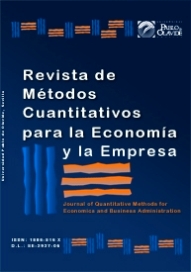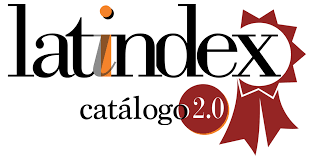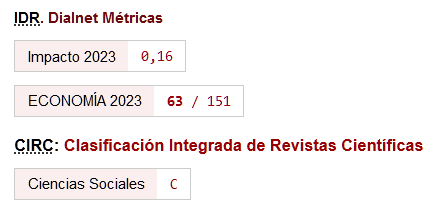Medición del grado de digitalización en las organizaciones culturales y creativas
DOI:
https://doi.org/10.46661/rev.metodoscuant.econ.empresa.7708Palabras clave:
Digitalización, Índice, Empresas, Componentes PrincipalesResumen
El presente artículo tiene como objetivo presentar el índice de digitalización elaborado para una muestra de organizaciones relacionadas con las actividades culturales y creativas en Colombia, a partir de los datos recolectados en la encuesta aplicada por instituciones oficiales y universidades iberoamericanas que hacen parte del Observatorio Iberoamericano de la Mipyme, a diversas micro, pequeñas y medianas empresas de Iberoamérica. El método empleado para obtener el índice de digitalización fue el de Análisis de Componentes Específicos (ACE), y en este caso el indicador contempla tres dimensiones, que son importantes considerar: implementación y desarrollo de la digitalización; desempeño comercial a través de la digitalización, y obstáculos de la digitalización.
Descargas
Citas
Arias-Pineda, A. A., & Ramírez - Martínez, L. (2019). La organización-empresa: ¿un sistema vivo? Aportes de la
teoría de la complejidad y la filosofía ambiental a la teoría administrativa y organizacional. Revista
Escuela de Administración de Negocios, 86, 133–150. https://doi.org/10.21158/01208160.n86.2019.2298 DOI: https://doi.org/10.21158/01208160.n86.2019.2298
Asociación Nacional de Empresarios de Colombia (ANDI). (n.d.). Informe de la Encuesta de Transformación
Digital 2019
Asun, R. (2019). Memorias del diplomado en Análisis Factorial. Recuperado de: http://halweb.uc3m.es/esp/Personal/personas/jmmarin/esp/AMult/tema4am.pdf
Bernal, C. A. (2010). Metodologìa de la Investigaciòn: Para Administraciòn; Economìa: Humanidades y Ciencias Sociales. 3ra Ediciòn.
Caquea, M, Rodríguez, C & Núñez, M. (2010). Los factores Humanos que inciden en la productividad y sus dimensiones. XIV congreso de ingeniería Organizacional. Recuperado de: https://www.researchgate.net/publication/259570281_Los_factores_humanos_que_inciden_en_la_productividad_y_sus_dimensiones
Deloitte. (s, f). From supply-chains to supply networks. Recuperado de: https://www2.deloitte.com/nl/nl/pages/enterprise-technology-and-performance/articles/from-supply-chain-to-a-supply-networks.html
Fernández, S. d. (2011). Análisis Factorial. Madrid: Universidad Autonoma de Madrid. Obtenido de Universidad Carlos III de Madrid - Uc3m: http://halweb.uc3m.es/esp/Personal/personas/jmmarin/esp/AMult/tema4am.pdf
Figueras M, S. (2000). Introducción al Análisis Multivariante. Obtenido de 5campus.com, Estadistica
Fundación Centro de Investigaciones y Asistencia Técnica Internacional JFK - CIATI-JFK (2022). Evolución de las “Cadenas de Suministro”. Recuperado de https://nmvsoluciones.com/ciati/ Plataforma de autoevaluación de la gestión de las Redes de Suministro y las Redes Logísticas Digitales, Sostenibles e Inclusivas. (s.f.).
Kilpatrick, J. Barter, L. 2020. DELOITTE. COVID-19: Gestión del riesgo y las interrupciones en la cadena de suministro. Deloitte Global.
Kraft, C., Lindeque, J. P., & Peter, M. K. (2022). The digital transformation of Swiss small and medium-sized enterprises: insights from digital tool adoption. Journal of Strategy and Management, 15(3), 468–494. https://doi.org/10.1108/JSMA-02-2021-0063 DOI: https://doi.org/10.1108/JSMA-02-2021-0063
Lambert, D. (2014). Customer relationship management process. En Fisher College of Lambert Business. Ohio State University. Supply Chain Management: Processes, Partnerships, Performance. Tercera edición. (25 – 41). Sarasota Supply Chain Management Institute.
Leinwand, P., Matt Mani, M. (2022) Beyond Digital: How Great Leaders Transform Their Organizations and Shape the Future. Harvard Business Review Press.
Maroto, A. (2007). La productividad en el sector servicios: un análisis económico aplicado. Universidad de Alcalá. Recuperado de: https://www.researchgate.net/publication/236942291_La_productividad_en_el_sector_servicios_Un_analisis_economico_aplicado
Oliva, A., & Albesa, M. G. (2003). Investigaciones Europeas de Dirección y Economía de la Empresa. Pespectivas Teóricas Sobre La Digitalización De Las Organizaciones Universidad Rovira i Virgili. 9, 49–62.
Prodi, E., Tassinari, M., Ferrannini, A., & Rubini, L. (2022). Industry 4.0 policy from a sociotechnical perspective: The case of German competence centres. Technological Forecasting and Social Change, 175(September 2021), 121341. https://doi.org/10.1016/j.techfore.2021.121341 DOI: https://doi.org/10.1016/j.techfore.2021.121341
Sahid, F. Pinzón, F. (14 de junio de 2021) Gestión de Redes de Suministro y Redes Logísticas Digitales, Sostenibles e Inclusivas El Modelo GPRDSI V2-2021. [Ponencia] Congreso Internacional de Logística. Redes de Suministro Digitales. El futuro de la Logística, HOY. Mesa Sectorial de Logística.
Sahid, F. Pinzón, F. Rodríguez, R. Pinzón, B. Flores, L. (2022). Gestión de Redes de Suministro y Redes Logísticas Digitales, Sostenibles e Inclusivas. CIATI-JFK / Mesa Sectorial de Logística- SENA.
Šimberová, I., Korauš, A., Schüller, D., Smolíkova, L., Straková, J., & Váchal, J. (2022). Threats and Opportunities in Digital Transformation in SMEs from the Perspective of Sustainability: A Case Study in the Czech Republic. Sustainability (Switzerland), 14(6). https://doi.org/10.3390/su14063628 DOI: https://doi.org/10.3390/su14063628
Sinha, A., Bernardes, E., Calderón, E. y Wuest, T. (2021). Digital Supply Networks. Transform your Supply Chain and gain competitive advantage with disruptive technology and reimagined processes. Mc. Graw Hill.
Temmen, M. (29 de septiembre de 2020). Linear Supply Chain Vs Digital Supply Network.
hupplySttps://marian-temmen.medium.com/linear-supply-chain-vs-digital-supply-networks- 74919b3a95b6
Descargas
Publicado
Cómo citar
Número
Sección
Licencia
Derechos de autor 2024 Leidy Maritza Silva Rodríguez

Esta obra está bajo una licencia internacional Creative Commons Atribución-CompartirIgual 4.0.
El envío de un manuscrito a la Revista supone que el trabajo no ha sido publicado anteriormente (excepto en la forma de un abstract o como parte de una tesis), que no está bajo consideración para su publicación en ninguna otra revista o editorial y que, en caso de aceptación, los autores están conforme con la transferencia automática del copyright a la Revista para su publicación y difusión. Los autores retendrán los derechos de autor para usar y compartir su artículo con un uso personal, institucional o con fines docentes; igualmente retiene los derechos de patente, de marca registrada (en caso de que sean aplicables) o derechos morales de autor (incluyendo los datos de investigación).
Los artículos publicados en la Revista están sujetos a la licencia Creative Commons CC-BY-SA de tipo Reconocimiento-CompartirIgual. Se permite el uso comercial de la obra, reconociendo su autoría, y de las posibles obras derivadas, la distribución de las cuales se debe hacer con una licencia igual a la que regula la obra original.
Hasta el volumen 21 se ha estado empleando la versión de licencia CC-BY-SA 3.0 ES y se ha comenzado a usar la versión CC-BY-SA 4.0 desde el volumen 22.










